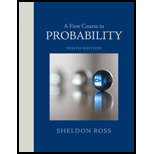
The joint density of X and Y is given by
a. Compute the joint moment generating function of X and Y.
b. Compute the individual moment generating
Want to see the full answer?
Check out a sample textbook solution
Chapter 7 Solutions
A First Course in Probability
- Answer questions 8.3.5 and 8.3.6 respectivelyarrow_forward8.6.4 Consider the test on the compressive strength of concrete described in Exercise 8.2.9. Compute a 90% prediction interval on the next specimen of concrete tested. 8.6.5 . SS Consider the fuel rod enrichment data described in Exercise 8.2.11. Compute a 90% prediction interval on the enrichment of the next rod tested. Compare the length of the prediction interval with the length of the 99% CI on the population mean.arrow_forwardAnswer questions 8S10 and 8S11 respectively.arrow_forward
- 8.4.6 Information on a packet of seeds claims that 93% of them will germinate. Of the 200 seeds that were planted, only 180 germinated. a. Find a 95% confidence interval for the true proportion of seeds that germinate based on this sample. b. Does this seem to provide evidence that the claim is wrong? 8.6.1 Consider the tire-testing data described in Exercise 8.2.3. Compute a 95% prediction interval on the life of the next tire of this type tested under conditions that are similar to those employed in the original test. Compare the length of the prediction interval with the length of the 95% CI on the population mean.arrow_forwardAnswer questions 8.3.1 and 8.3.2 respectivelyarrow_forward8.2.7 The brightness of a television picture tube can be evaluated by measuring the amount of current required to achieve a particular brightness level. A sample of 10 tubes results in x = 317.2 and s = 15.7. Find (in microamps) a 99% confidence interval on mean current required. State any necessary assumptions about the underlying distribution of the data. 8.2.8 An article in the Journal of Composite Materials (December 1989, Vol. 23(12), pp. 1200–1215) describes the effect of delamination on the natural frequency of beams made from composite laminates. Five such delaminated beams were subjected to loads, and the resulting frequencies (in hertz) were as follows: 230.66, 233.05, 232.58, 229.48, 232.58 Check the assumption of normality in the population. Calculate a 90% two-sided confidence interval on mean natural frequency.arrow_forward
- 8.2.5 An article in Obesity Research [“Impaired Pressure Natriuresis in Obese Youths” (2003, Vol. 11, pp. 745–751)] described a study in which all meals were provided for 14 lean boys for three days followed by one stress test (with a video-game task). The average systolic blood pressure (SBP) during the test was 118.3 mm HG with a standard deviation of 9.9 mm HG. Construct a 99% one-sided upper confidence interval for mean SBP. 8.2.6 An article in Medicine and Science in Sports and Exercise [“Maximal Leg-Strength Training Improves Cycling Economy in Previously Untrained Men” (2005, Vol. 37, pp. 131–136)] studied cycling performance before and after 8 weeks of leg-strength training. Seven previously untrained males performed leg-strength training 3 days per week for 8 weeks (with four sets of five replications at 85% of one repetition maximum). Peak power during incremental cycling increased to a mean of 315 watts with a standard deviation of 16 watts. Construct a 95% confidence…arrow_forwardthey take? 8.1.13 WP GO Tutorial An article in the Journal of Agricultural Science ["The Use of Residual Maximum Likelihood to Model Grain Quality Characteristics of Wheat with Variety, Climatic and Nitrogen Fertilizer Effects” (1997, Vol. 128, pp. 135–142)] investigated means of wheat grain crude protein content (CP) and Hagberg falling number (HFN) surveyed in the United Kingdom. The analysis used a variety of nitrogen fertilizer applications (kg N/ha), temperature (°C), and total monthly rainfall (mm). The following data below describe temperatures for wheat grown at Harper Adams Agricultural College between 1982 and 1993. The temperatures measured in June were obtained as follows: 15.2 14.2 14.0 12.2 14.4 12.5 14.3 14.2 13.5 11.8 15.2 Assume that the standard deviation is known to be σ = 0.5. a. Construct a 99% two-sided confidence interval on the mean temperature. b. Construct a 95% lower-confidence bound on the mean temperature. c. Suppose that you wanted to be 95% confident that…arrow_forward8.1.1 WP For a normal population with known variance σ², answer the following questions: - a. What is the confidence level for the interval x — 2.140/ √√n≤≤+2.140/√√n?arrow_forward
- 8.1.8 A civil engineer is analyzing the compressives trength of concrete. Compressive strength is normally distributed with σ2 = 1000(psi)2. A random sample of 12 specimens has a mean compressive strength ofx = 3250 psi. a. Construct a 95% two-sided confidence interval on mean compressive strength. b. Construct a 99% two-sided confidence interval on mean compressive strength. Compare the width of this confidence interval with the width of the one found in part (a). 8.1.9Suppose that in Exercise 8.1.8 it is desired to estimate the compressive strength with an error that is less than 15 psi at 99% confidence. What sample size is required?arrow_forward8.1.12 Ishikawa et al. [“Evaluation of Adhesiveness of Acinetobacter sp. Tol 5 to Abiotic Surfaces,” Journal of Bioscience and Bioengineering (Vol. 113(6), pp. 719–725)] studied the adhesion of various biofilms to solid surfaces for possible use in environmental technologies. Adhesion assay is conducted by measuring absorbance at A590. Suppose that for the bacterial strain Acinetobacter, five measurements gave readings of 2.69, 5.76, 2.67, 1.62, and 4.12 dyne-cm2. Assume that the standard deviation is known to be 0.66 dyne-cm2. a. Find a 95% confidence interval for the mean adhesion. b. If the scientists want the confidence interval to be no wider than 0.55 dyne-cm2, how many observations should they take?arrow_forwardAnswer questions 8.2.1 and 8.2.2 respectivelyarrow_forward
 Linear Algebra: A Modern IntroductionAlgebraISBN:9781285463247Author:David PoolePublisher:Cengage LearningAlgebra & Trigonometry with Analytic GeometryAlgebraISBN:9781133382119Author:SwokowskiPublisher:Cengage
Linear Algebra: A Modern IntroductionAlgebraISBN:9781285463247Author:David PoolePublisher:Cengage LearningAlgebra & Trigonometry with Analytic GeometryAlgebraISBN:9781133382119Author:SwokowskiPublisher:Cengage Elements Of Modern AlgebraAlgebraISBN:9781285463230Author:Gilbert, Linda, JimmiePublisher:Cengage Learning,
Elements Of Modern AlgebraAlgebraISBN:9781285463230Author:Gilbert, Linda, JimmiePublisher:Cengage Learning,


